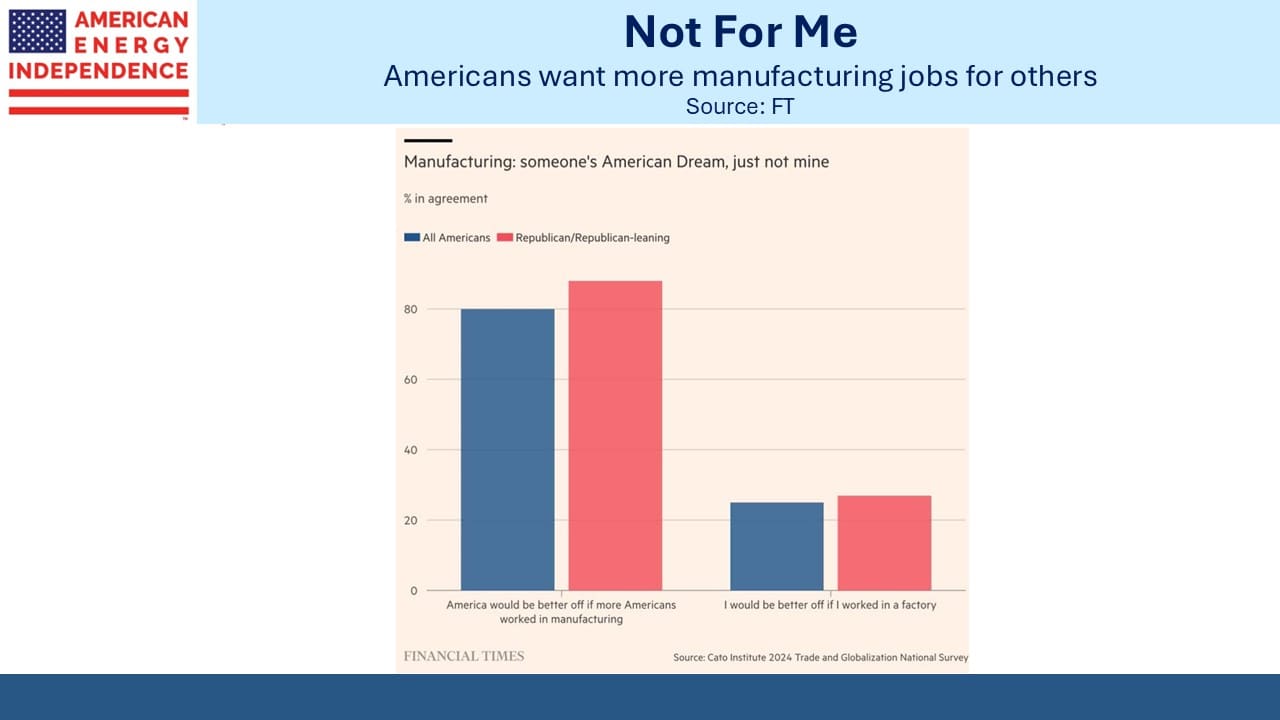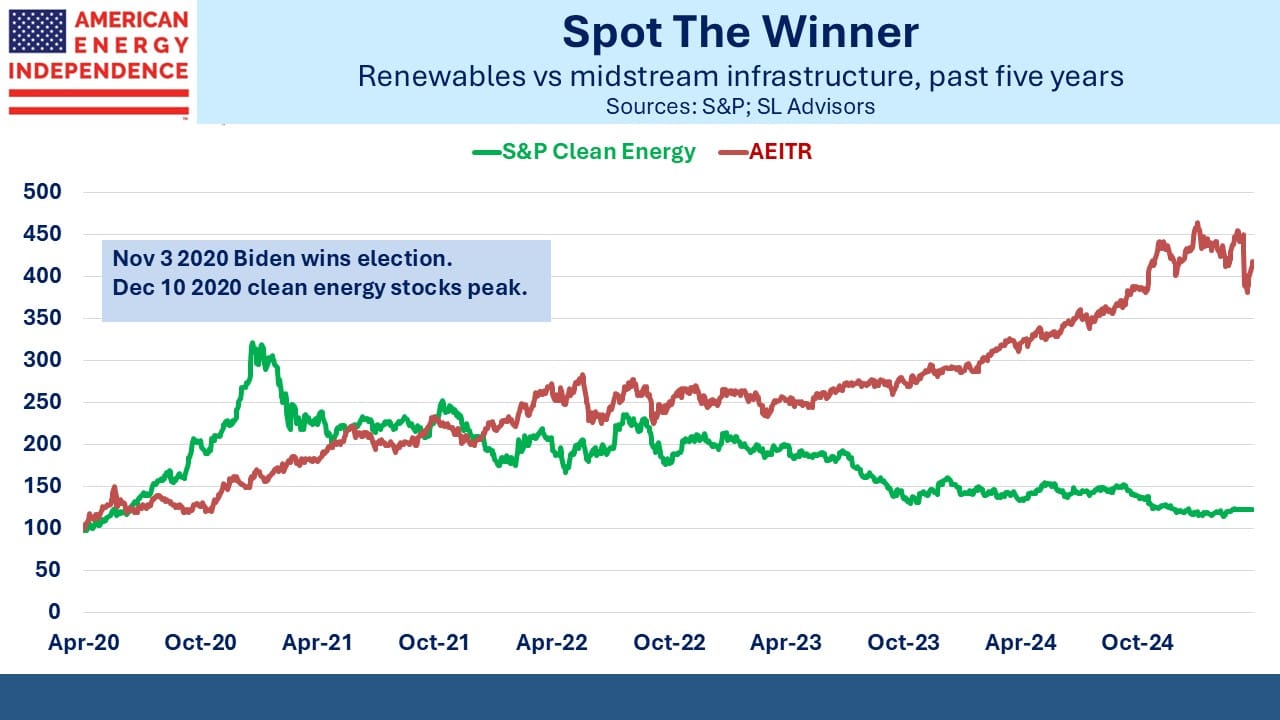Tariffs Soften Presidential Support

/
Tariff turmoil and the market’s gyrations have elicited more than normal feedback on recent blog posts. Politically, our readers and investors tend to be Republican so many are inclined to look for positives in Liberation Day and the subsequent policy switches. Some echo Trump’s claim that foreign countries have been exploiting the US for years. Canada’s banking market and EU autos are two examples cited.
But the majority of responses express dismay if not alarm at the tariffs – mostly at their unexpected magnitude and unpredictable execution. History shows that Trump usually attempts to implement his campaign rhetoric, so 60%+ tariffs on China should not surprise anyone who followed his campaign last year.
Anecdotal evidence of the disruption is starting to emerge. An importer of cotton bathrobes from China is scouring the world for alternative suppliers since no US manufacturing capability exists. A small company that relies on textile imports and another that manufactures safety equipment with foreign sourced parts are both facing existential threats to their margins. A major manufacturer of paper cups faces tariffs on its exports to Canada, where insufficient domestic capacity exists to provide a replacement.
There persists this romantic notion that America would benefit from making more stuff here. Some critical supply chains should be domestic. We found we were overly reliant on personal protective equipment from China during the pandemic, ironically the source of the outbreak. Polls show that Americans overwhelmingly believe more of us should work in manufacturing as long as it’s someone else.
The public criticism of Fed chair Jay Powell and pressure to cut rates have not been well received by markets. One especially strong Trump supporter told me that, “The US is now universally viewed as an increased credit risk.”
The upside case for investors requires that Trump 2.0 will measure results by the stock market, like Trump 1.0. Our investors largely voted for him, and their happiness is being eroded with each decline of the S&P500. This theory suggests that eventually a combination of now-less-wealthy donors and fears of a mid-term voter reaction against chaos will ameliorate said policies before they do too much harm. I do sense among some readers growing fatigue over chaotic policy and falling markets.
It’s best not to rely too heavily on politics in committing capital. Clean energy bulls learned this lesson when Joe Biden won the presidency in 2020. Assuming that their political views and desired returns were in alignment, investors poured money into a sector that has become a serial disappointment.
Even limitless government subsidies couldn’t offset the intermittency of weather-dependent power and the range anxiety of EVs. Betting on profits from the energy transition has been a fool’s errand. A Democrat in the White House couldn’t alter the physics.
Voters care about combating climate change as long as it doesn’t cost them money. Democrats have failed to convince them that it’s worth paying more for low-carbon power. Climate change barely registered as a concern during the last election, far behind unchecked illegal immigration and inflation.
This blog has taken the pragmatic view that it’s worth reducing emissions and increasing cleaner-burning natural gas consumption as a coal substitute is the most impactful way forward. The science and investment returns vindicated this view.
Elections haven’t historically caused us to change our investment approach. More recently, neither has tariff turmoil. That the world is going to use more energy and that US natural gas will play an important role have always been enduring themes.
Trump’s robust advocacy of US oil and gas exports is a welcome change from Joe Biden. I listened to Larry Summers on an All-In podcast last week criticizing the Biden administration both for canceling the Keystone XL pipeline in 2021 and for the pause on new LNG permits in 2024. Summers was Treasury Secretary under Clinton from 1999-2001. His criticism of Biden shows how Democrat policies have shifted left in recent years.
The midstream sector’s prospects were good anyway, but the new Administration’s support for LNG exports has helped. Energy Transfer’s recent Heads of Agreement (HOA) with MidOcean Energy to jointly develop their Lake Charles LNG export terminal is an example of how the Trump Administration’s refreshing support for energy exports is attracting capital.
In another case, the Army Corp of Engineers granted national energy emergency status for Enbridge’s (ENB) Line 5 oil pipeline tunnel project. Environmentalists have opposed this even though owner ENB is seeking to replace the existing pipeline which they say may leak.
It’d be a shame for the tariff turmoil to detract from other more constructive policies.
We have two have funds that seek to profit from this environment:

Important Disclosures
The information provided is for informational purposes only and investors should determine for themselves whether a particular service, security or product is suitable for their investment needs. The information contained herein is not complete, may not be current, is subject to change, and is subject to, and qualified in its entirety by, the more complete disclosures, risk factors and other terms that are contained in the disclosure, prospectus, and offering. Certain information herein has been obtained from third party sources and, although believed to be reliable, has not been independently verified and its accuracy or completeness cannot be guaranteed. No representation is made with respect to the accuracy, completeness or timeliness of this information. Nothing provided on this site constitutes tax advice. Individuals should seek the advice of their own tax advisor for specific information regarding tax consequences of investments. Investments in securities entail risk and are not suitable for all investors. This site is not a recommendation nor an offer to sell (or solicitation of an offer to buy) securities in the United States or in any other jurisdiction.
References to indexes and benchmarks are hypothetical illustrations of aggregate returns and do not reflect the performance of any actual investment. Investors cannot invest in an index and do not reflect the deduction of the advisor’s fees or other trading expenses. There can be no assurance that current investments will be profitable. Actual realized returns will depend on, among other factors, the value of assets and market conditions at the time of disposition, any related transaction costs, and the timing of the purchase. Indexes and benchmarks may not directly correlate or only partially relate to portfolios managed by SL Advisors as they have different underlying investments and may use different strategies or have different objectives than portfolios managed by SL Advisors (e.g. The Alerian index is a group MLP securities in the oil and gas industries. Portfolios may not include the same investments that are included in the Alerian Index. The S & P Index does not directly relate to investment strategies managed by SL Advisers.)
This site may contain forward-looking statements relating to the objectives, opportunities, and the future performance of the U.S. market generally. Forward-looking statements may be identified by the use of such words as; “believe,” “expect,” “anticipate,” “should,” “planned,” “estimated,” “potential” and other similar terms. Examples of forward-looking statements include, but are not limited to, estimates with respect to financial condition, results of operations, and success or lack of success of any particular investment strategy. All are subject to various factors, including, but not limited to general and local economic conditions, changing levels of competition within certain industries and markets, changes in interest rates, changes in legislation or regulation, and other economic, competitive, governmental, regulatory and technological factors affecting a portfolio’s operations that could cause actual results to differ materially from projected results. Such statements are forward-looking in nature and involves a number of known and unknown risks, uncertainties and other factors, and accordingly, actual results may differ materially from those reflected or contemplated in such forward-looking statements. Prospective investors are cautioned not to place undue reliance on any forward-looking statements or examples. None of SL Advisors LLC or any of its affiliates or principals nor any other individual or entity assumes any obligation to update any forward-looking statements as a result of new information, subsequent events or any other circumstances. All statements made herein speak only as of the date that they were made. r
Certain hyperlinks or referenced websites on the Site, if any, are for your convenience and forward you to third parties’ websites, which generally are recognized by their top level domain name. Any descriptions of, references to, or links to other products, publications or services does not constitute an endorsement, authorization, sponsorship by or affiliation with SL Advisors LLC with respect to any linked site or its sponsor, unless expressly stated by SL Advisors LLC. Any such information, products or sites have not necessarily been reviewed by SL Advisors LLC and are provided or maintained by third parties over whom SL Advisors LLC exercise no control. SL Advisors LLC expressly disclaim any responsibility for the content, the accuracy of the information, and/or quality of products or services provided by or advertised on these third-party sites.
All investment strategies have the potential for profit or loss. Different types of investments involve varying degrees of risk, and there can be no assurance that any specific investment will be suitable or profitable for a client’s investment portfolio.
Past performance of the American Energy Independence Index is not indicative of future returns.




Leave a Reply
Want to join the discussion?Feel free to contribute!